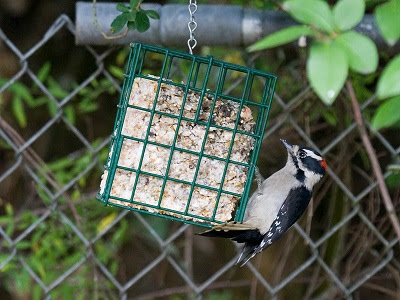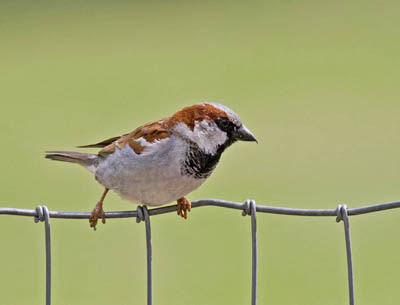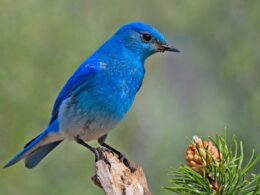Last Updated on December 27, 2023 by Greg Gillson
What birds come to feeders in New York?
This article and accompanying videos discuss the most common birds at bird feeders in New York throughout the year. Other feeder birds may be more common seasonally, but these should be present most of the year.
I start with a quick list of New York feeder birds and then provide more information if you are so interested.
Feeding birds in New York can bring much joy!
Here are 10 birds that you are most likely to see at your bird feeder in New York:
- Blue Jay
- Northern Cardinal
- Black-capped Chickadee
- Mourning Dove
- American Goldfinch
- Song Sparrow
- European Starling
- Downy Woodpecker
- Red-winged Blackbird
- House Sparrow
The most common feeder bird in New York is the Blue Jay. Read more about it, below.
 |
| Blue Jay. skeeze Pixabay |
Black-capped Chickadee
 |
| Black-capped Chickadee. Greg Gillson |
The cute Black-capped Chickadees must be one of the favorite birds at feeders across much of North America.
They are year-round residents in Alaska and across Canada south across the northern half of the United States.
These birds are found in deciduous and mixed woods, orchards, and backyards. They feed in small flocks acrobatically on the end of twigs, searching for invertebrates and small seeds.
In winter they make up the core of roaming mix feeding flocks. These flocks include chickadees, kinglets, nuthatches, and often include Brown Creepers, Downy Woodpeckers, Yellow-rumped Warblers, and wrens.
These are small birds, smaller than House Finches. They are about the same length as American Goldfinches. The bodies of chickadees are round and plump. They have big heads and long tails that flit about. They have long legs and big feet. The bills are short and stout. This allows them to eat both seeds and invertebrate foods.
These birds are gray above and buffy below. They have striking black caps and bibs, offset by their white face. You may also notice the white secondary wing edges of the folded wing. Genders are identical in appearance.
At your feeder, Black-capped Chickadees love black oil sunflower seeds. They take these one-at-a-time to a nearby branch. They hold the seed with their feet and pound the shell open with their bill to get the kernel inside. In fall they often take the whole seed away and store it for the winter, in what is called a cache.
Northern Cardinal
 |
| Northern Cardinal. Greg Gillson |
Northern Cardinals are one of the most popular birds in the United States. Even people who haven’t seen one in life have seen their image on logos and advertisements.
These birds are year-round residents from the northeastern United States south to Florida, west to the Midwest, southern Great Plains to Arizona.
They are found in woodlands, hedgerows, and dense backyard shrubs.
Both males and females sing, a series of repeated whistles.
These birds are less bulky than European Starlings, but just as long. The have a very long tail and big head with tall crest.
The bill is very thick at the base, short, with curved edges. It is usually obviously orange.
Males are bright red throughout, with hints of blue on the wings, tail, and back. They have a black throat patch that reaches to the eye and over the bill.
Females are dull brown or buffy yellow in coloration with red highlights on the edges of the wings and tail. Their crest isn’t quite as pronounced as the males. They still show the black around the bill.
Northern Cardinals eat larger seeds at your feeder, including black oil sunflower seeds and safflower seeds.
Red-winged Blackbird
 |
| Red-winged Blackbird. Greg Gillson |
Red-winged Blackbirds are common birds across North America.
In summer they are found from Alaska, across Canada, south into Mexico. In winter they abandon much of Canada and the northern Great Plains and Midwest.
They nest in marshes in summer, where there are cattails and similar plants. In winter they spread out into fields, cattle lots, and residential neighborhoods. These birds are colonial nesters in cattail marshes.
In fall and winter, they form very large flocks composed of many young-of-the-year, starlings, grackles, cowbirds, and other blackbirds. Such flocks can number in the hundreds of thousands, especially in the East.
These birds are about the size of American Robins, perhaps a bit smaller. They are stocky with a fairly long tail. They have rather flat foreheads that accentuate the long bill. The bill is fairly stout at the base, long, pointed, and straight on the upper and lower edges.
Males are glossy black with yellow-edged red shoulders that can be hidden in the scapular feathers when the wings are at rest.
Females are a bit smaller than males. They are pale with heavy brown streaks on the under parts. Some populations show buff on the face. They may confuse beginners into thinking they are some kind of streaky sparrow. The flat crown and very straight and sharply pointed bill point to their identification as blackbirds.
At your feeder they will eat black oil sunflower seeds and suet.
American Goldfinch
 |
| American Goldfinch. Greg Gillson |
The American Goldfinches are favorite backyard birds across North America. Many people call them “wild canaries.”
These active birds are year-round residents coast-to-coast across northern and mid-latitudes of the United States.
In summer birds move into southern Canada. In winter birds are found throughout the United States.
They are found in weedy pastures and brushy clearings. In town, they favor parks and residential areas with lawns and scattered trees. They often feed on thistles or dandelion seeds on the ground. But they also fly over open spaces between trees with a bounding roller-coaster flight and a lilting “potato chip” call.
These are small birds, smaller than House Finches. They are rather plump birds with small round heads and short tails. The bill is small but it is conical for eating seeds. It is colored pink.
Summer males are striking with their brilliant yellow and black plumage. The body is yellow and they have a black crown. The wings and tail feathers are black and white.
Females are duller olive-green without the black crown. They have thin white wing bars.
Juvenile birds in fall show striking tan wing bars on the black wing.
In winter both genders are pale gray and tan with brown wings and tail. They may only show a hint of yellow on the head and throat.
At your feeder, American Goldfinches love black oil sunflower seeds and Niger seed. They are especially common at feeders in summer and fall.
Mourning Dove
 |
| Mourning Dove. Greg Gillson |
The mournful summer song of Mourning Doves is familiar to most, even if they don’t know what bird makes the sound.
They are found across the United States as year-round residents. Birds summer in the northern Great Plains and south central Canada, but withdraw in winter.
These birds are found in towns and farms, and open country with scattered trees, often along rivers.
In spring they sing from power lines in residential areas. They may puff out their chests while cooing from the peak of your roof.
These birds are much larger than European Starlings, but also much smaller than American Crows. These birds have large powerful breasts, a tiny round head on thin neck, and long pointed tail. Their wings are somewhat pointed in flight. The bill is small as typical for all pigeons. Genders are identical.
These birds are warm tan or brown colored. The breast has a pinkish hue. The wings are gray. They have a few large black spots on the wing coverts. They have a black spot on the side of the neck below the cheek that sometimes shows some iridescent green feathers. The tail has white edges, best seen in flight.
At your bird feeder Mourning Doves eat all types of seeds. They are also attracted to water for drinking and bathing.
Downy Woodpecker
 |
| Downy Woodpecker. Greg Gillson |
Downy Woodpeckers are tiny and common visitors to backyards across the United States.
These woodpeckers inhabit nearly all of North America south of the tundra and away from the driest deserts.
Often found near water, they like small deciduous trees, willows, and brush. Common in backyards.
Like other woodpeckers, these birds hitch up small trees. However, they often cling to the small outer branches. They even hang on twigs and small bushes such as wild rose and teasel.
They are bigger than House Finches, smaller than Red-winged Blackbirds, but shaped differently than either. These birds have stocky bodies and big heads. They have short, stiff, pointed tails. The legs are short. The feet are large with strong claws. The bills of these woodpeckers are chisel shaped but especially short and petite.
The overall pattern of these birds is black-and-white stripes. The wings are black with numerous white spots and bars. The back is white. The underparts are white or tinged with buff. The face is white; the crown and nape is black, the ear covert black, and there is a black malar stripe. The tail is black with white outer tail feathers. Males have a red spot on the nape that females lack.
Downy Woodpeckers eat suet at your feeder.
Blue Jay
 |
| Blue Jay. skeeze Pixabay |
Blue Jays are one of the most well-known birds in the United States.
Birds are found year-round east of the Rocky Mountains from southern Canada to Texas and eastward. There is a noticeable migration of some of their population in most of their range. Birds move northward into the Great Plains of Canada for the summer.
Though they are found in woodlands of all type, they are especially attracted to oak trees. They are common in residential areas, too.
Brash and conspicuous, Blue Jays have a complex social structure. The more the crest is raised, the more excited or agitated the bird is.
Jays are fairly large backyard birds. They are just a bit larger than American Robins. These are stout birds with large rounded or wedge-shaped tails. They have large legs and feet. They have a bushy crest. The bill is fairly long, strong.
Genders are similar in plumage. They are blue above, including the crest. They are gray below with a black necklace across the throat. The wings are barred with black, with white wing bars and trailing edges. The blue tail is barred with black and has white tail corners.
At your feeder, Blue Jays love whole peanuts and sunflower seeds.
Song Sparrow
 |
| Song Sparrow. Greg Gillson |
Song Sparrows are widespread across North America.
These birds summer from southern Alaska and across Canada to the Ohio River Valley and in the West to southern California and Arizona. In winter most birds leave Canada and the northern Great Plains, except for a population in western Canada. The winter birds push south to Florida and Texas into northern Mexico.
These birds are found in a wide variety of brushy habitats. They are found in open woodlands, marshes, and backyards landscaped with large bushes and brambles.
They spend a lot of time hopping on the ground looking for food. They eat insects and invertebrates in summer, but mostly seeds in winter.
They are a bit smaller than House Sparrows. They have a round body, round head, and longer tail with a rounded tip. The bill is triangular, short and thick at the base.
Across their range these birds show much variation. Desert birds are paler. Northwestern birds are dark and reddish. Alaskan birds are much larger. In general, they are gray, streaked with brown, with breast streaks forming a center spot on the breast. The pattern of the head is complex but rather diagnostic. The white throat is bordered by a flaring lateral throat stripe. Genders are identical.
Song Sparrows will visit platform feeders, but more likely stay under dense bushes, venturing out on the ground below the feeder.
European Starling
 |
| European Starling. Greg Gillson |
Starlings are often mistaken for blackbirds, but they are in a different bird family and don’t share a lot of similarities, other than a general black coloration.
These birds are year-round residents from southeast Alaska across southern Canada and all of the lower 48 states into northern Mexico. In addition, birds move northward into northern Canada in summer.
They are found in urban, suburban, fields, and orchards. In autumn and winter they gather into huge flocks, often with blackbirds. They are frequently aggressive at feeders, driving off other birds.
These birds have the body size of an American Robin, but a much shorter tail. They are about 8-1/2 inches long from bill tip to tail tip. They have plump bodies, rather large heads, and short tails. Wings are short and pointed in flight, almost triangular. Their bills are long and pointed.
Dark brown worn birds in late summer get fresh new feathers in fall. Then their iridescent black feathers are tipped with white chevrons. These gradually wear off during the winter and spring. By summer they are mostly black, without many spangles.
Breeding birds have yellow bills, the bills are brown in the non-breeding season. Both genders are colored the same.
Because of their aggressive nature, most people do not like starlings at their bird feeders. Starlings have weak feet, so have trouble eating from tube feeders and special upside-down suet feeders.
House Sparrow
 |
| House Sparrow. Greg Gillson |
House Sparrows were first introduced into the United States in 1851 and quickly became common coast-to-coast.
These birds are year-round residents from Canada south through Mexico. They originally were birds of Europe and Asia, but have colonized basically every human-occupied city in the world.
Towns and cities are the primary habitats of these birds. Wherever there are permanent human settlements, these birds are there. They choose to nest in houses, buildings, and other human-made structures, but also in nest boxes provided for other birds. They also thrive in farms and ranches, especially stables and grain storehouses.
These are social birds, often found in large flocks. They tend to squabble and have a complex hierarchy. Males are dominant in fall and winter, but females dominate in spring and summer. They also tend to be aggressive toward other birds at the feeder.
These sparrows are not related to New World Sparrows. Thus they are differently shaped. They have a short body and full breast, large head, and short tail. The bill is triangular: short pointed but thick at the base. The bill of female and fall males is dull yellowish. The bill of spring males is black.
In fresh fall plumage males are dingy brown above, with dark stripes on the back, dusty brown on wings and tail, with a gray rump. They have one large white upper wing bar. They have a bit of black on the chin. As their pale feather tips wear off during winter and spring, the black bib on the male reveals itself. The crown becomes grayer, the face whiter, and chestnut patches on the nape and shoulder become more obvious.
Females remain in a dull plumage all year. The under parts are dingy gray. Upper parts dull brown with dark lines on the back. They also show a small white upper wing bar. The face shows a brown crown and stripe behind the eye, offset by a wide buffy eyebrow.
At the feeder House Sparrows eat a wide variety of seeds, but they like cracked corn and red milo (ingredients found in cheaper bird seed) that many native sparrows and finches do not like. They also have rather weak feet. So to reduce the number of House Sparrows at your feeder, switch to black oil sunflower seeds in a tube feeder.
Recommended Products for feeding birds in New York
Amazon Affiliate Links
If you are looking for feeders and bird food, here are products I use or recommend. If you purchase from these links, I earn a small commission. Thank you for your support.
This hopper feeder is just the right size and durable. The best high quality mixed bird seed for this bird feeder that I highly recommend is Wagner’s Songbird Supreme. This combination attracts the widest variety of feeder birds.
I really like how this iBorn copper tube feeder looks in my yard. It is best for finches and chickadees when filled with black oil sunflower seed.
For attracting woodpeckers and chickadees, and keeping out jays, starlings, and grackles, I love my Nature’s Way Upside-Down Suet Feeder. I also buy St. Albans Bay suet.
For common backyard birds and birds at your feeder, this is a good little book.
I’m using these Celestron Nature DX ED 8x40s almost exclusively now. I am impressed that such a low-priced binocular has such good image quality. Perfect for beginners! Yes, there are better binoculars at $500, $1000, $2000. But why? They’re not that much better.
Links to other articles on this blog
Feeding winter birds in New York
Red, Orange & Yellow Birds of New York








